Croy, North Lanarkshire
Croy is a village in North Lanarkshire, Scotland. A former mining community, Croy is situated some 13 miles (21 km) from Glasgow and 37 miles (60 km) from Edinburgh on the main railway line between the two cities.[1] Croy has a population of about 1,390.[2]
Croy
| |
|---|---|
 View from Croy Hill looking towards Culmuir View, with the Bar Hill area in the distance. | |
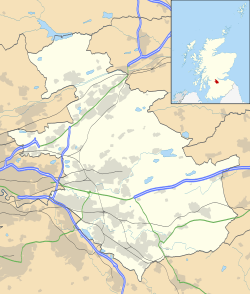 Croy Location within North Lanarkshire | |
| Population | 1,390 (mid 2012 estimate) |
| OS grid reference | NS624553 |
| Council area | |
| Lieutenancy area | |
| Country | Scotland |
| Sovereign state | United Kingdom |
| Post town | GLASGOW |
| Postcode district | G65 9 |
| Dialling code | 01236 |
| Police | Scotland |
| Fire | Scottish |
| Ambulance | Scottish |
| UK Parliament | |
| Scottish Parliament | |

Croy railway station is the transport hub for the surrounding area and is one of the busiest stations in the Scottish Central Belt. The station has frequent services seven days a week to Glasgow, Edinburgh and Stirling. The station has undergone significant expansion in recent years including extended platforms, increased car parking facilities, and a new station building & ticket office. The line has been electrified as part of the Edinburgh to Glasgow Improvement Programme.
Antonine Wall
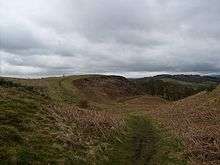
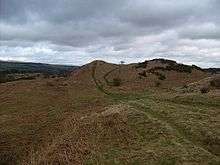
On Croy Hill, to the north east of the village, are remnants of the Antonine Wall, built by the Romans between AD 142 and 144, including a fort and two beacon platforms. Croy hill's neighbouring forts were Barr Hill to the west and Westerwood to the east. Two communication platforms known as ‘expansions’ can be seen to the west of the fortlet.[3] Alexander Park excavated the site in 1890-1891.[4] Sir George Macdonald wrote about his excavation of the site which occurred in 1920, 1931, and 1935.[5] At Croy Hill, the ditch in front of the rampart was not excavated by the Romans. It is likely that hard basalt and dolerite of the hill was virtually impossible to shape with Roman tools. This is the only place along the Wall where the ditch was not dug.[6] There is a bath house just outside one fort.[7]
Mining Town
The modern settlement of Croy as it appears today is primarily the result of a coal mine being established in the mid-1800s. This attracted a sizable population of Irish immigrants to the area seeking employment and is the reason for the village's strong Roman Catholic origins. A single row of original miners' cottages is still present and occupied on the Constarry Road high street; the cottages feature highly distinctive red brickwork and are exceptionally well preserved. Locals affectionately refer to the row as 'Coronation Street' due to the similarity with the houses of the iconic UK television series.
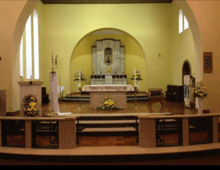
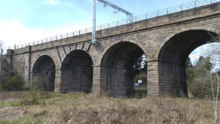
Croy has a Roman Catholic primary school (Holy Cross Primary)[8] and a large Catholic church (Holy Cross Church) that services a substantial congregation from all over the local area. The church has been established for over 100 years and has some impressive architectural features; the church bells are rung prior to each service and can be heard throughout the village.[9][10] Another impressive architectural feature is the Croy Railway Viaduct (known locally as the four arches). Built in the mid-1800s, the viaduct can be accessed via a heritage path running alongside Croy station. The path was redeveloped with the Croy station improvements and is now well signposted and more easily accessible. In 2013 it was announced that Croy Quarry, near the World Heritage Site of the Antonine Wall, was to close. Aggregate Industries lost their license to extract minerals at the end of 2017.[11]
Croy Miners Welfare Club and other amenities
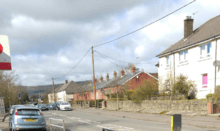
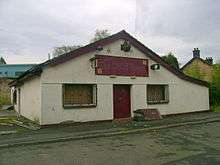
In 2002 the Croy Miners Welfare Charitable Society received a grant from the National Lottery Community Fund of £500,000. The grant was used to demolish the old Croy Miners Welfare Club and build a large multi-functional leisure facility to house several of the area's groups and societies.[12] Those using the building included the Croy Historical Society, Croy Silver Band, and the Croy Male Voice Choir.[13] Despite the sizable investment, the club suddenly closed its doors and declared insolvency without warning in 2012. The reason for this is not known and the building remains closed to date. The club's legal status is currently classed as dissolved[14] and reports indicate the building is to be put up for sale in the near future.[15]
Other amenities in the village include a newsagents/post office, Chinese takeaway, Indian takeaway, bakery, barbershop, and Salon. The village once had a pub named the Celtic Tavern, later known as The Croy Tavern, but this ceased trading in the early 2000s and was eventually demolished. A car wash now stands in its place.
Croy Shrine

A notable feature of the village is the Croy Shrine located in the Nethercroy area to the North East. The Shrine was built around a natural spring in the mid 1970s by local residents and featured a statue of The Virgin Mary in a grotto scene with a stone channel in front to allow access to the spring water.[16] The Shrine fell into a state of disrepair over the years due to neglect and vandalism. In 2013 some local residents rebuilt it and a rededication ceremony was held in 2014.
Sports
Antonine Community Sports Hub

In 2012 a state of the art £1 million pound sports facility was opened in the village.[17] Spearheaded by local residents and part financed by North Lanarkshire Council,[18] the facility is home to a full size 3G football pitch with enclosure and stadium quality floodlighting, a 2 floor community pavilion with changing rooms and meeting area, and additional goalposts and line markings to allow conversion to 3 smaller football pitches when needed.
Links to Celtic F.C.
Despite the small scale of the village, Croy has a series of remarkable high-profile links with Scottish football team Celtic.[19] At one stage there was a junior (non-league) football team in the village, known as Croy Celtic. The village had a pub named The Celtic Tavern[20] and in the late 1990s it featured prominently in matchday programmes. The village is almost exclusively populated with Celtic supporters and has a large Supporters Club (Croy CSC).[21]
Former player Jimmy Quinn, considered a Celtic legend and one of the club's greatest ever players[22] lived in the village and former Celtic owner Fergus Mccann, the man credited with saving the club from extinction and now recognised as one of the most important figures in the club's history,[23] lived in Croy and was the social convener of the Croy Celtic Supporters Club.[24]
In addition to Jimmy Quinn, former Celtic players who lived in the village include Andy McAtee, John Morrison,[25] Francis Meechan,[26] Tom McAteer, James Culley,[27] Pat McMahon, and Jimmy Quinn (grandson of Jimmy Quinn named above). Former Celtic players not from the village but who played for Croy Celtic include Arthur McInally,[28] Tommy McInally,[29] Frank Murphy,[30] and Andrew Miller.[31]
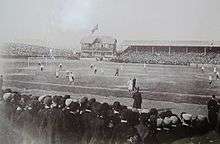
Notable residents
Other people of note with links to the village include Scottish folk singer and accordion player Will Starr.[32] and former WBO Flyweight world champion boxer Pat Clinton.[33]
In July 2020 local resident and the serving SNP counciller for Kilsyth and Croy, Mark Kerr, was charged by Police Scotland with 5 offences relating to historic sexual abuse. Due to Mr Kerrs position as a serving government official, the charges generated attention nationwide from various news outlets. A court case is pending.[34]
References
- "Croy". Retrieved 4 January 2016.
- "Estimated population of localities by broad age groups, mid-2012" (PDF). Retrieved 3 January 2018.
- "Antonine Wall, Croy Hill Roman Signal Platform (East)". Canmore. Historic Environment Scotland. Retrieved 14 October 2017.
- Rohl, Darrell, Jesse. "More than a Roman Monument: A Place-centred Approach to the Long-term History and Archaeology of the Antonine Wall" (PDF). Durham Theses. Durham University. Available at Durham E-Theses Online ref: 9458. Retrieved 14 October 2017.
- Macdonald, Sir George (1934). The Roman wall in Scotland, by Sir George Macdonald (2d ed., rev., enl., and in great part rewritten ed.). Oxford: The Clarendon press. pp. 258–270. Retrieved 11 October 2017.
- "Castlecary Antonine Wall Fort". Roman Britain. Archived from the original on 5 June 2018. Retrieved 10 October 2017.
- "Croy Hill and the Antonine Wall, near Kilsyth". Walk Highlands. Retrieved 19 October 2017.
- "Our School". Retrieved 4 January 2016.
- "Monklands Memories- Story of Croy". Archived from the original on 5 January 2016. Retrieved 7 January 2016.
- http://www.heritagepaths.co.uk/pathdetails.php?path=64
- "Quarry falls silent". Cumbernauld News. 17 January 2018. Retrieved 19 January 2018.
- "Croy miners dig up Lottery gold". Retrieved 4 January 2016.
- "History group set the record". Retrieved 4 January 2016.
- company check ltd (4 January 2016). "CROY MINERS' WELFARE CHARITABLE SOCIETY. Free business summary taken from official companies house information. Free alerts. Registered as SC400493". Company Check. Retrieved 4 January 2016.
- "Hepburn Concerned about Croy Miners Welfare Centre Future". Jamie Hepburn MSP. Archived from the original on 19 February 2016. Retrieved 7 January 2016.
- "Shrine rededicated in Croy". Retrieved 4 January 2016.
- McCallum, Alison (22 March 2012). "Campaigners remembered at opening of new £1m Croy sports pitch". STV News. Retrieved 7 January 2016.
- "New sports facilities are one in a million!". North Lanarkshire Council. 22 April 2014. Retrieved 7 January 2016.
- "Celebration in Croy is just for the bhoys". The Herald. 4 June 2002. Retrieved 4 January 2016.
- "Archived copy". Archived from the original on 27 January 2016. Retrieved 8 January 2016.CS1 maint: archived copy as title (link)
- "VisitLanarkshire - Information about Croy". Retrieved 4 January 2016.
- "Hail the Mighty Quinn". Retrieved 5 January 2016.
- https://www.bbc.co.uk/sport/0/football/26373698
- Wilson, Richard (15 August 2014). "Celtic: Fergus McCann to banish blues with flag day return". BBC Sport. Retrieved 5 January 2016.
- John Morrison
- Francis Meechan
- James Culley
- Arthur McInally
- Tommy McInally
- Frank Murphy
- Andrew Miller
- "Will Starr: King of Scottish accordionists". 10 May 2011. Archived from the original on 25 January 2016.
- Keevins, Hugh (1 March 2014). "Pat Clinton crowned champion of the world". The Scotsman. Retrieved 7 January 2016.
- Hutcheon, Paul (16 July 2020). "North Lanarkshire councillor to appear in court over sexual abuse charge". dailyrecord.
